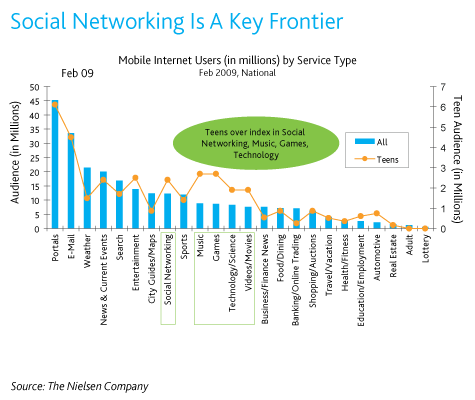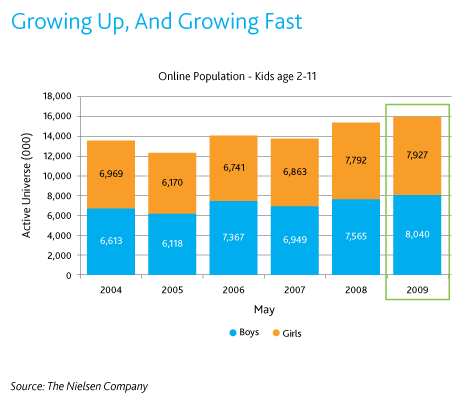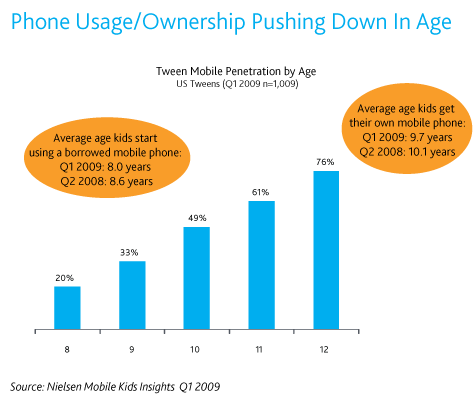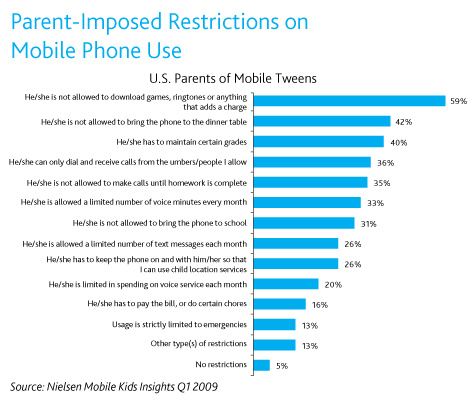
Pete Blackshaw, Executive Vice President, Digital Strategic Services, The Nielsen Company
SUMMARY: When is a phone not a phone? In the hands of children and tweens, today’s cell phones are primarily used as text messaging devices, cameras, gaming consoles, video viewers, MP3 players, and incidentally, as mobile phones via the speaker capability so their friends can chime in on the call. Parents are getting dialed in to the social media phenomenon and beginning to understand—and limit—how children use new media. This article draws from a keynote speech delivered last month at the Children’s Advertising Review Unit (CARU) annual conference.
Digital media is an enabling framework for brands, parents and educators—it’s on demand, interactive, sensing and connected. And social media adds expression and sharing capabilities. A vast menu of web and mobile tools has been developed to facilitate information sharing and commentary on the Web. Applications and outlets have kept pace as consumers rush to populate blogs, Twitter, YouTube, Facebook, forums, message boards and online communities.
In the marketing world, the buzz is all about consumer-generated media. Companies have discovered thatno paid-for communication campaign has the impact of missives penned by consumers grounded in relevant, first-hand experience. Their influence is immediate, highly viral and authentic, with an extremely long tail attributable to archived material.
Giving voice
What motivates people to go online and on the record with personal opinions and information? In part, it is the very human need to be heard and to connect with others. It is the desire to make a difference, to influence the world around us. It is the drive to evangelize on behalf of the things and the people we love. And it is the ongoing quest for authenticity in a world governed by image.
Mobile devices represent a major impetus behind the social media movement, driving part of the 250% audience increase for the year ending February 2009. Teens represented 19% of the 12.3 million active social networkers.
Childhood connections
To adults, cell phones are a communications device. To children, they are a lifeline. Consider that the average 13-17 year old sends more than 2,000 text messages per month. Compared with the total mobile Internet population, teens are much bigger consumers of social media, music, games, videos/movies and technology/science.

Parental use of advanced data services mirrors that of their tween kids. If their children text, then 80% of parents will text as well. Although following their kids’ lead on devices and media, parents still set limits. Six in ten forbid downloads onto their children’s phone for financial and security reasons.
TV times
Even as social media dominates press coverage, TV viewing is on the rise among children and teens. Younger children age 2–11 spend almost 102 hours per month watching traditional TV at home—a 17% increase from May of 2008 to the second quarter of 2009. The increasingly popular time-shifted TV option averaged 5:26 hours during the timeframe, a 26% year-over-year increase.

Traditional TV viewing expanded at a slower rate (13.5%) among teenagers than among younger kids—to 101+ hours, and teen time-shifted viewing showed a 35% growth rate with 4:54 hours of watching time. Interestingly, Internet use was down (-15%), to 10:22 hours per month. The biggest media gainer was video viewing on the Internet, where Hulu and YouTube helped spike time by 66% for a total 2:41 viewing hours. Teens deployed mobile phones to catch videos, spending 6:30 hours with mobile video streams—a 20% year-over-year increase.
Young enough
The debate rages on: what is the right age to give a child their own phone? The answer seems to be younger every year, and if you don’t give them a phone, they’ll just borrow one. In 2008, the average age when kids started to borrow a cell phone was 8.6 years; in 2009, it was down to just 8 years old. As to ownership, in 2008, a child typically was given a mobile phone at age 10.1 years; by 2009, it was down to 9.7 years old.

The next time you hear “everybody’s got one”, the fact is, that classic ploy may be true. By age 10, roughly half of children own a mobile phone. By age 11, six in ten own a mobile phone. By age 12, fully three-fourths of all children have their own mobile phone.
Game on
How do they use phones? Two-thirds of tween mobile phone owners took pictures with their camera phones in the last year. Half spent time playing the pre-installed games. Four in ten activated the speakerphone feature. Twenty-eight percent filmed a video clip, and 24% listened to the MP3 capability.
More than half of the youngest (age 8) mobile phone owners used their cell to send text messages in the last 12 months. That figure soared to 81% for 12-year-old mobile users. The vast majority of text messages were directed to friends and family (90%). All other cell phone uses tracked in the single digits, such as voting on TV shows (8%), buying a ringtone or music (9%), buying wallpaper or a screensaver (4%), buying a game (5%), responding to an ad (5%) or looking up their horoscope (4%).
Parental controls
Surprisingly, given all the publicity about cyber stalking and cyber bullies, more than half of parents do not apply any parental controls offered by service providers to their children’s cell phone usage—although the use of these paid-for controls is increasing. Among those who do assert these built-in controls, 20% limit the number of calls, texts or instant messages, followed by download limits (17%), talk time or voice minute allocations (16%), mobile website access limits (15%), locator services and restricted in/outgoing number access (13% each), time of day restrictions (11%), and alerts to unauthorized texts, IMs or callers (6% each).
While the use of paid-for controls may not be high, just about all parents restrict how tweens use their phone and six in ten prohibit downloads that incur charges. Not taking the phone to the dinner table and maintaining certain grades are other rules put in place by 42% and 40% of parents, respectively.

Coming challenges
From a media perspective, choice leads to fragmentation, and ultimately, divided consumer attention and diminished import for a single medium. Even as social media gains popularity among the general public and marketers, there is no accepted benchmark or measure of effectiveness, making it difficult to forecast or predict the impact of a campaign.
A particular challenge for companies wanting to incorporate social media into their communications arsenal is the blurred line between private and public information, given the highly personal nature of many postings. Advertising models are still in flux, exploring boundaries of ethics, taste and transparency.
Untapped potential
Social media presents a world of new possibilities. Not a better mousetrap, but a new operating DNA for interacting with consumers. It can serve as an early radar or warning system, alerting to trouble spots and yielding fresh insights.
For parents, old rules still govern new media. They will need to stay engaged, enrolled and involved in their children’s lives. The motto “trust but verify” applies. For advertisers, old rules also are still in force. The need for transparency and trustworthiness becomes amplified on new media circuits. Ultimately, the nature of new media will prove its value, as all parties engage in an interactive, ongoing, mutually beneficial conversation. Social media is organic and ever-evolving, constantly presenting new opportunities and challenges.



